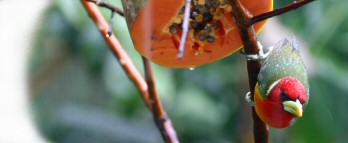Birding Trip to Costa Rica 25 FebruaryĖ8 March 2004
Participants: Ric and Betty Zarwell, Judi and Jerry LeTendre, Carol
and Tom Sykes, Marge Hill, and Kay Niyo. Richard Garrigues of Costa Rica
was our excellent guide. It was a great trip with ~352 species seen by
members of the group.
Click on thumbnails to see enlarged photos.
Wednesday, 25 February
I flew from Denver through Miami to San Jose a day early to use
frequent flyer miles. The room at Hotel Aeropuerto was nice with air
conditioning. Dinner and cervesa at the hotel dining room were
delicious.
Thursday, 26 February
|
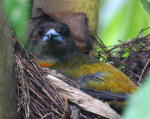
Passerini's Tanager female on nest |
Breakfast at the hotel was very good with fresh fruit,
scrambled eggs, beans/rice, and delicious candied plantain. Great
Costa Rican coffee! While eating on the veranda, I saw a Great
Kiskadee, Yellow-breasted Vireo, and the national bird,
Clay-colored Robin. A brown-gray squirrel called a variegated
squirrel that is similar to our eastern fox squirrel picked a
heavy mango off a tree in the garden and managed to carry it to a
branch where he ate it! I spent the day birding and learning my
new Canon Rebel with the Canon 100-400 IS lens. Lunch was very
good with complimentary chips and three delicious dips with each
meal! The exchange rate is 421 Colones = $1, but they also use
U.S. dollars. I birded the hotel grounds in the afternoon and saw
eight species with a Passerini's Tanager on a nest and a pair of
Rufous-napped Wrens being the most exciting. It was a pleasant 75
degrees with a light breeze and cloudy to partly cloudy. Dinner
was delicious. The rest of our group arrived at 10 p.m.
|
Friday, 27 February (Day 1 of official trip)
We met Richard Garrigues, our guide, and Memo, our
excellent driver of a 25-passenger Toyota Tourismo bus, to depart
at 5 a.m. for birding at El Rodeo Forest Reserve south of San
Jose. We returned to the hotel for breakfast about 8:30 a.m.,
loaded the bus, and left for Poas Volcano Lodge.
Richard said a large Caribbean weather system was
pushing rain into northeastern Costa Rica. It began raining as we
drove north toward Poas Volcano Lodge, which is at about 7,200'.
We stopped in heavy rain at Cinchona, a small,
open-air shop and viewing point with many fruit and hummingbird
feeders, which was a great place for viewing hummers a few feet
away. We saw lots of birds including an Emerald Toucanet,
Crimson-collared Tanager, Silver-winged Tanager, Red-headed
Barbet, Green Hermit, Violet Sabrewing, Brown Violet-ear, Green
Thorntail, Steely-vented Hummingbird, Coppery-headed Emerald,
White-bellied Mountain-gem, Purple-throated Mountain-gem. We also
saw a white-nosed agouti. They had a pet Mealy Parrot on a stand.
We drove further up the mountain to Poas Volcano
Lodge. It is a beautiful old remodeled stone lodge owned by an
Englishman who was there. The chefs served gourmet food for dinner
and breakfast. Richard assured us that we donít need to worry
about quality of food or water anywhere we will be staying, which
was reassuring to those of us who have experienced lesser
conditions in other countries. We compiled our list before a fire
in a sunken fireplace, which felt good due to the cold, damp
weather. We birded out the window and didnít have a view of the
volcano, which was unfortunate because it evidently is a beautiful
sight.
|
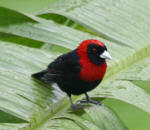
Crimson-collared Tanager
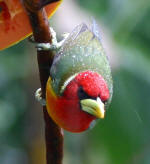
Red-headed Barbet
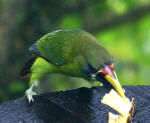
Emerald Toucanet
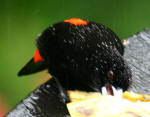
Passerini's Tanager |
Saturday, 28 February (Day 2)
|
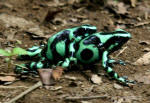
Harlequin Poison Dart Frogs |
We arose early and after a delicious breakfast and birding out
the rainy window, we headed up Hwy. 4 and around the loop to La
Selva Biological Station, one of the Organization of Tropical
Studies (OTS) research stations. On the way, we stopped at Salva
Verde Lodge, a private 500-acre retreat, for a hike and lunch. We
saw an emerald basilisk, green iguana, and strawberry and
harlequin poison dart frogs. It was raining lightly but warm when
we arrived at the La Selva OTS Biological Station. They served
good cafeteria-style food at all meals.
|
Sunday, 29 February (Leap Year!) (Day 3)
Mantled howler monkeys woke us every morning at La
Selva. We went into the rainforest with Rudolpho, an OTC guide, in
the morning. There are extensive cement trails in part of the
forest. Rudolpho pointed out two hummingbird nests and a
Double-toothed Kite. We hiked to the old research station building
that is in disrepair and serves as a bat research area for the
white-lined sac-wing bat.
We had rain and more rain, but, finally, we were
able to walk down the road in the afternoon. We had great birds
when we were able to get out.
There was a Crested Guan and a Collared Aracari in
a leafless tree right by the cafeteria. Masked and Black-crowned
Tityras also frequented that tree.
Seen in the nearby trees and flowering shrubs were
Common Tody Flycatcher, Bright-rumped Atilla, Passeriniís Tanager,
Blue-gray Tanager, Olive-backed Euphonia, Silver-throated Tanager,
Golden-hooded Tanager, Scarlet-thighed Dacnis, Red-legged
Honeycreeper, White-necked Puffbird, Collared Aracari, Keel-billed
Toucan, Chestnut-mandibled Toucan, Violet-headed Hummingbird,
Blue-chested Hummingbird, the nearly ubiquitous Rufous-tailed
Hummingbird, and the Bronze-tailed Plumeleteer. The Passerini's
Tanager was making a nest in a shrub along the road.
|
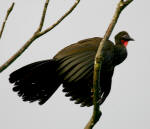
Crested Guan
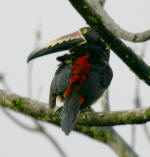
Collared Aracari
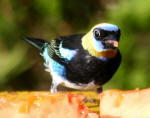
Golden-hooded Tanager |
Monday, 1 March (Day 4)
|
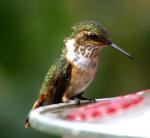
Volcano Hummingbird female
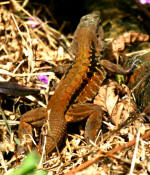
Festive Whiptail
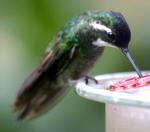
Gray-tailed Mountain-gem
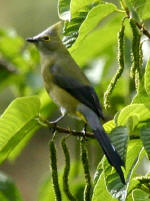
Long-tailed Silky Flycatcher
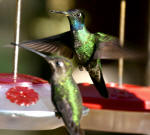
Focus on Magnificent Hummingbird |
We birded La Selva in the morning and then drove back up
through Puerto Viejo on the same route, down to north of San Jose,
and then on Hwy. 32 to Parque Nacional Braulio Carrillo.
We stopped at El Tapir, a defunct hummingbird garden, and saw
lots of hummers including Black-crested Coquette while we ate
lunch. We also saw a Festive Whiptail in the garden.
We hiked in the tropical forest of Braulio Carrillo in the park
on a narrow, dark trail with very dense growth. It was rather slow
birding until we found antbirds foraging in an ant colony. They
eat the other insects that the ants stir up, and I also saw one
bird "anting" or preening using an ant. The group had great looks
at Chestnut-backed, Spotted, and Bicolored Antbirds, and some of
us had good looks at Ocellated Antbird.
We heard two Tawny-crested Eagles calling and saw them fly
overhead. One that Richard thought was a juvenile landed in a far
away tree. They prey on monkeys and we had just seen probably a
howler monkey in a tree that was hunkering down while the
eagles were calling.
We drove along the continental divide at about 10,000' and onto
the western slope down a very steep curvy road to Savegre Mountain
Lodge in the late afternoon. The family that owns Savegre produces
apples from orchards planted in cleared patches on some of the
very steep mountainsides. We had great looks at a Large-footed
Finch scratching in the leaves along the road as we were driving
into the lodge.
We had drinks and a delicious buffet-style dinner including
wonderful candied plantain again! The grounds are full of flowers
and shrubs and grassy areas ó a really beautiful place with lots
of hummingbird feeders and hummers including Volcano Hummingbird,
Green Hermit, Green Violet-ear, Gray-tailed Mountain-gem,
Magnificent Hummingbird, and Scintillant Hummingbird. To bed at 9
p.m. in lovely small cabins.
|
Tuesday, 2 March (Day 5)
|
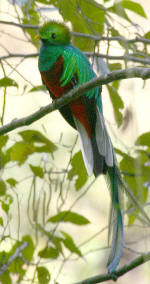
Resplendent Quetzal male
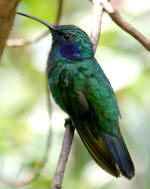
Green Violet-ear
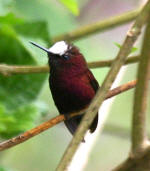
Snowcap |
We arose early for a delicious buffet-style breakfast. We rode
in a pickup truck up a steep road into old growth forest and then
hiked back down. It was very quiet in the old growth forest when
we first started hiking, but we saw some good birds a little
farther down including Ruddy Treerunner, Buffy Tuftedcheek,
Gray-breasted Woodwren.
Walking back down along a creek was more birdy with good looks
at Black-billed Nightingale Thrush and several Ruddy-capped
Nightingale Thrushes. We also saw Black-faced Solitaire.
We had a delicious lunch and then walked in the gardens and
along the river. As we started out, there was a Long-tailed Silky
Flycatcher in a nearby shrub. A friendly male Collared Redstart
wanted to land on Carolís hand but decided not to chance it! We
also saw a Flame-throated Warbler in the same area.
We walked down the road and Richard set up his scope on
a mystery bird in the shadows of a large tree. It was a female
Resplendent Quetzal, which is the bird that Marge had really
wanted to see! There was a man photographing it with a Canon 500
mm lens. There also was a male quetzal in a nearby tree, and the
photographer and his wife told us the pair had been going in and
out of a nest hole in a tree along the river. I took lots of
photos through the dark tree limbs and leaves and managed to get
some decent shots.
Later while walking back, a male Resplendent Quetzal without
the long tail feathers flew over Richardís head. We also saw a
Collared Trogon.
We walked up a small stream and saw some nice birds including
several Ruddy-capped Nightingale Thrushes. We then enjoyed
margaritas and another delicious dinner and retired at 8:30 p.m.
|
Wednesday, 3 March 2004 (Day 6)
We enjoyed an early breakfast at Savegre Lodge and then
departed up the steep winding road getting our only looks at
Mountain Robin.
We drove up to a very high point at timberline (> 11,000')
where there were lots of radio and microwave towers. There we saw
Volcano Junco and Timberline Wren, a very secretive little wren
living in very dense, short vegetation that includes a native
bamboo. We enjoyed beautiful views of the valley and the Pan
American Highway (Hwy. 2) when the clouds and mist coming up from
the eastern slope and trickling down the Pacific side allowed.
We continued down to Hwy. 2 and arrived at Dr. Alexander F.
Skutchís home and research station about 11:15 a.m. We were in
luck because he was still sitting by his window reading, and he
warmly welcomed us into his home. He will be 100 years old on 20
May 2004! We all shook hands with him and told him where we live.
He signed my and Carolís books. He is very alert and sharp and
looks like he is about 70 years old! He is amazing. He came to
Costa Rica over 60 years ago as a botanist working on coffee. He
became interested in birds and coauthored A Guide to the Birds
of Costa Rica, which was published in 1989.
We ate our sack lunches at a picnic table in Dr. Skutch's yard
while enjoying many birds. I photographed a Gray-headed Tanager
eating bananas that Richard had placed on a feeder tray near the
picnic table. We saw a Northern Barred-Woodcreeper on the forest
edge. There also was a Red-crowned Woodpecker, a very loud Rufous
Piha, and a Fork-tailed Flycatcher (the only place on the trip we
saw it). During our drive we stopped to see a Black Hawk-Eagle.
We continued down Hwy. 2 and 236 through San Vito to the Wilson
Botanical Gardens, which also is the Las Cruces OTS station. It is
a beautiful place with several 10-yr-old buildings that were built
to replace older ones that burned. They are built on a hill site,
so the dining area, which served delicious food family style, has
a large balcony with long tables where we could enjoy meals while
looking out over a wide valley with mountains in the distance.
Each individual room with two twin beds had a private balcony
overlooking nearby trees and shrubs. So there were always parrots,
parakeets, etc. calling and landing in the trees.
After arriving, we birded the gardens and saw some great birds:
Crimson-fronted Parakeet, White-headed Parrot, Red-thighed and
Green Honey Creepers. We finished the evening with a delicious
dinner, compiled our group list as we did every evening, and
retired about 8:30 p.m.
|
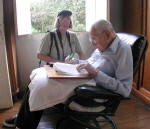
Dr. Alexander F. Skutch signing Kay's
book (this photo by Tom Sykes)
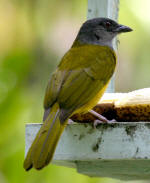
Gray-headed Tanager
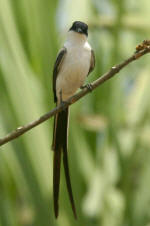
Fork-tailed Flycatcher

Ric, Tom, Jerry, Richard
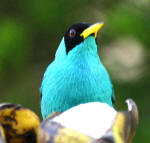
Green Honeycreeper male
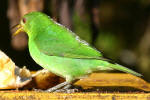
Green Honeycreeper female |
Thursday, 4 March 2004 (Day 7)
|
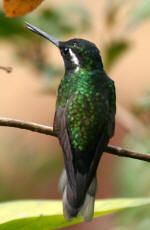
Purple-throated Mountain-gem
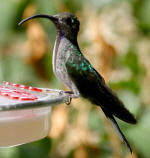
Violet Sabrewing
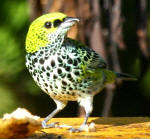
Speckled Tanager |
We spent all day at Las Cruces OTC (Wilson Botanical Gardens).
We walked trails through the forest down to the river in the
morning and within the gardens and heard Marbled Wood-Quail. Some
of the birds we saw were Crimson-fronted and Orange-chinned
Parakeets, Blue-headed and White-crowned Parrots, Vaux's Swift,
Garden Emerald, Beryl-crowned Hummingbird, Long-billed Starthroat,
Golden-olive Woodpecker, Buff-throated Foliage-gleaner, Plain
Xenops, Plain Antvireo, Slaty Antwren, Mistletoe Tyrannulet,
Scale-crested Pygmy-Tyrant, Bright-rumped Attila, White-winged
Becard, Rose-throated Becard, Rufous-breasted Wren, Tropical
Gnatcatcher, Orange-billed Nightingale Thrush, the ubiquitous
Clay-colored Robin and Tennessee Warbler (both seen every day),
Tropical Parula, Blackburnian Warbler, American Redstart,
Slate-throated Redstart, Buff-rumped Warbler, Common Bush Tanager,
Summer Tanager, Black-cheeked Ant-Tanager, Yellow-crowned Euphonia,
Thick-billed Euphonia, Speckled Tanager, Scarlet-thighed Dachnis,
Green Honeycreeper.
In the afternoon, we went to San Juakeen Marsh (private), where
we had great looks at one Wattled Jacana and several Northern
Jacana, a female Masked Duck, Purple Gallinule with a fluffy slate
gray chick, Green Heron, and Blue-winged Teal. The owner showed us
around his marsh and also showed us his familyís two pet rabbits,
3-month-old black poodle, and milk cow with a very young calf.
We then drove to within about a mile of the Panama border to a
pasture with a huge baobab tree that had several Crested
Oropendula nests and several birds courting. This was a life bird
for Richard. A researcher who does contract surveys told Richard
that he discovered this colony just inside the Panama/Costa Rica
border. They were previously only known to be in Panama and
further south.
|
Friday, Saturday, Sunday, 5, 6, and 7 March 2004 (Days 8, 9, and 10)
We birded Wilson Gardens early in the morning and left about 9
a.m. for Bosque del Rio Tigre on the Osa Peninsula, traveling
south until we joined the Pan American Highway (Hwy. 2) again at
Ciudad Neily. We headed northwest until just past Piedras Blancas
where we took a paved road around the Golfo Dulce. It was a 5-hr
drive, but we drove through interesting wilderness and then banana
and oil palm plantations. We saw Magnificent Frigatebird, Wood
Stork, and Brown Pelican on the way. We stopped on the peninsula
at a bridge over the Rio Rincon. There were shore birds including
Willet, Spotted Sandpiper, and Whimbrel on the river sandbars. The
bridge was only one lane wide and had a very large hole in the
floor that someone had partially covered with sheet metal and a
board. So we had to keep running off the bridge when cars and
trucks came over it. One of the trucks was a very large logging
truck filled with large logs. Most of us exited the bridge for
that one!
We continued down the peninsula to within a few miles of Pto
Jimenez where we drove inland following the Rio Tigre. We went
through the very small village of Tigre and followed a few
marginal signs for Bosque del Rio Tigre Lodge to a river crossing
with no bridge! Our great driver, Memo, got out and walked to the
river to check the feasibility of crossing it in our 25-passenger
Toyota bus. He came back and said it looked doable! It turned out
to be three crossings over three foot-deep braids of the river! We
made it fine and arrived at the most unusual lodge during our
trip!
Liz Jones and Abraham Gallo bought 30 acres that was formerly a
gold mining area and built a unique lodge in a clearing just above
the river about seven years ago! It is a two-story square building
with four open air bedrooms on the second floor! The beds (twins
or doubles) have mosquito netting draped from ceiling to floor! We
didnít really need the netting, however, because there were no or
few mosquitoes or other insects! Rainfall is great there though,
and it did rain on and off while we were there. The temperature
was probably 85 degrees in the day and the humidity felt like it
was the same or greater! But it was pleasant. The food was gourmet
and served with wine at a large dining table on the open-air first
floor.
There were a few feeders that attracted the Blue-crowned Motmot,
Cherrie's Tanager, and a few hummers. Liz and Abraham have carved
trails through the rain forest and we saw many amazing birds.
There is a large pond that contained nesting Boat-billed Herons, a
Least Grebe, and caiman. We saw and photographed adult Boat-billed
Herons, a heron chick in the nest, and a heron nest with three
white eggs! We visited a small area in the forest and watched a
male Orange-crowned Manakin do his click dance to attract females.
We saw King Vulture along with Black and Turkey Vultures;
Swallow-tailed and Double-toothed Kites; Tiny, Roadside, and
Short-tailed Hawks; White-throated Crake; and Gray-necked
Wood-Rail. We had long looks at Scarlet Macaws and saw
Orange-chinned Parakeet; Brown-hooded, Blue-headed, White-crowned,
and Red-lored Parrots. I photographed an obliging Squirrel Cuckoo
from the second floor bedroom and saw Striped Cuckoo. We saw the
Costa Rican Swift. New hummers for the trip included White-tipped
Sicklebill and nest, White-crested Coquette, Blue-throated
Goldentail. Trogans included Bairdís, Violaceous, and Slaty-tailed.
Blue-crowned Motmot was utterly tame here! We saw Green
Kingfisher, Fiery-billed Aracari, several Chestnut-billed Toucans,
Buff-throated Foliage-gleaner, Scaly-throated Leaf-tosser,
Black-striped Woodcreeper, Great Antshrike, Black-hooded Antshrike,
Dot-winged Antwren, Turquoise Cotinga, Scrub and Lesser Greenlets,
Plain and Scaly-breasted Wrens, White-shouldered Tanager,
Thick-billed Euphonia, Blueblack Grassquit, and Orange-billed
Sparrow.
Other fauna seen here included spectacled caiman, black river
slider, red-headed gecko, forest gecko, white-lined bat, proboscis
bat, brown-throated three-toed sloth, Hoffman's two-toed sloth,
and painted turtle. We also saw many click beetles.
On the way to the airport at Pto Jimenez on the 7th, we saw one
adult and two juvenile Yellow-headed Caracaras. We flew from a
very small airport in a 12-passenger plane for a 47-minute flight
over the bay, along the Pacific coast, and through the mountains
to San Jose. We had a delicious farewell dinner at the Hotel
Aeropuerto that evening and said goodbye to Richard and Memo after
doing our final-day list. Marge bought everyone a margarita to
celebrate seeing her first Resplendent Quetzal!
It was a great trip with a companionable group of people. Our
driver, Memo, was superb and always smiling. Richard is a
phenomenal naturalist, guide, and birder. He knows all the birds
by call, song, and sight. And he knows the flora and other fauna
equally as well. We talked to him about arranging another trip to
some other areas of Costa Rica. It was a great trip and no one
wanted to see it come to an end when we flew home on the 8th.
We finished our trip with approximately 352 bird species seen
by the various group members. Costa Rica is home to more than 830
bird species.
|

Memo driving bus across Rio Tigre
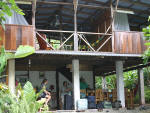
Bosque del Rio Tigre Lodge
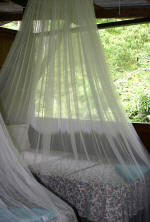
Canopy beds at Rio Tigre
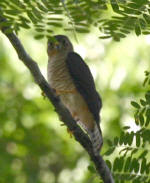
Tiny Hawk
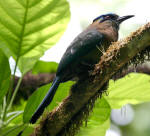
Blue-crowned Motmot
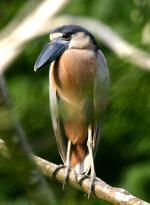
Boat-billed Heron
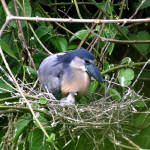
Boat-billed Heron with chick
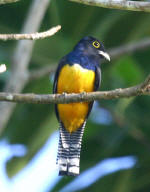
Violaceous Trogon
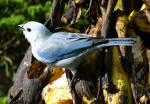
Blue-gray Tanager

Ric, Betty, Jerry, Judi, Kay, Richard,
Marge, Tom, Memo, Carol |
|

